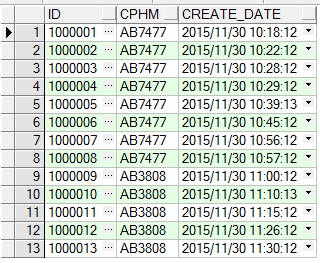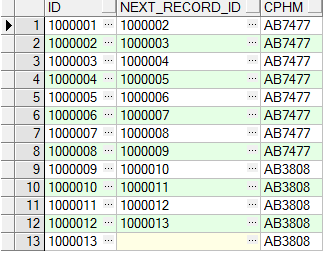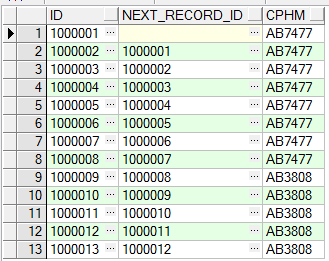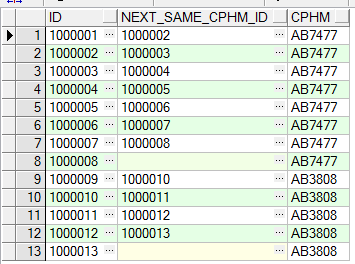一、簡介
lag與lead函數是跟偏移量相關的兩個分析函數,通過這兩個函數可以在一次查詢中取出同一字段的前N行的數據(lag)和後N行的數據(lead)作為獨立的列,從而更方便地進行進行數據過濾。這種操作可以代替表的自聯接,並且LAG和LEAD有更高的效率。
over()表示 lag()與lead()操作的數據都在over()的范圍內,他裡面可以使用partition by 語句(用於分組) order by 語句(用於排序)。partition by a order by b表示以a字段進行分組,再 以b字段進行排序,對數據進行查詢。
例如:lead(field, num, defaultvalue) field需要查找的字段,num往後查找的num行的數據,defaultvalue沒有符合條件的默認值。
二、示例
1、表機構與初始化數據如下
1 -- 表結構
2 create table tb_test(
3 id varchar2(64) not null,
4 cphm varchar2(10) not null,
5 create_date date not null,
6 primary key (id)
7 )
8 -- 初始化數據
9 insert into tb_test values ('1000001', 'AB7477', to_date('2015-11-30 10:18:12','YYYY-MM-DD HH24:mi:ss'));
10 insert into tb_test values ('1000002', 'AB7477', to_date('2015-11-30 10:22:12','YYYY-MM-DD HH24:mi:ss'));
11 insert into tb_test values ('1000003', 'AB7477', to_date('2015-11-30 10:28:12','YYYY-MM-DD HH24:mi:ss'));
12 insert into tb_test values ('1000004', 'AB7477', to_date('2015-11-30 10:29:12','YYYY-MM-DD HH24:mi:ss'));
13 insert into tb_test values ('1000005', 'AB7477', to_date('2015-11-30 10:39:13','YYYY-MM-DD HH24:mi:ss'));
14 insert into tb_test values ('1000006', 'AB7477', to_date('2015-11-30 10:45:12','YYYY-MM-DD HH24:mi:ss'));
15 insert into tb_test values ('1000007', 'AB7477', to_date('2015-11-30 10:56:12','YYYY-MM-DD HH24:mi:ss'));
16 insert into tb_test values ('1000008', 'AB7477', to_date('2015-11-30 10:57:12','YYYY-MM-DD HH24:mi:ss'));
17 -- ---------------------
18 insert into tb_test values ('1000009', 'AB3808', to_date('2015-11-30 11:00:12','YYYY-MM-DD HH24:mi:ss'));
19 insert into tb_test values ('1000010', 'AB3808', to_date('2015-11-30 11:10:13','YYYY-MM-DD HH24:mi:ss'));
20 insert into tb_test values ('1000011', 'AB3808', to_date('2015-11-30 11:15:12','YYYY-MM-DD HH24:mi:ss'));
21 insert into tb_test values ('1000012', 'AB3808', to_date('2015-11-30 11:26:12','YYYY-MM-DD HH24:mi:ss'));
22 insert into tb_test values ('1000013', 'AB3808', to_date('2015-11-30 11:30:12','YYYY-MM-DD HH24:mi:ss'));
表初始化數據為:

2、示例
a、獲取當前記錄的id,以及下一條記錄的id
select t.id id ,
lead(t.id, 1, null) over (order by t.id) next_record_id, t.cphm
from tb_test t
order by t.id asc
運行結果如下:

b、獲取當前記錄的id,以及上一條記錄的id
select t.id id ,
lag(t.id, 1, null) over (order by t.id) next_record_id, t.cphm
from tb_test t
order by t.id asc
運行結果如下:

c、獲取號牌號碼相同的,當前記錄的id與,下一條記錄的id(使用partition by)
select t.id id,
lead(t.id, 1, null) over(partition by cphm order by t.id) next_same_cphm_id, t.cphm
from tb_test t
order by t.id asc
運行結果如下:

d、查詢 cphm的總數,當create_date與下一條記錄的create_date時間間隔不超過10分鐘則忽略。
1 select cphm, count(1) total from 2 ( 3 select t.id, 4 t.create_date t1, 5 lead(t.create_date,1, null) over( partition by cphm order by create_date asc ) t2, 6 ( lead(t.create_date,1, null) over( partition by cphm order by create_date asc ) - t.create_date ) * 86400 as itvtime, 7 t.cphm 8 from tb_test t 9 order by t.cphm, t.create_date asc 10 ) tt 11 where tt.itvtime >= 600 or tt.itvtime is null 12 group by tt.cphm
結果如下:
